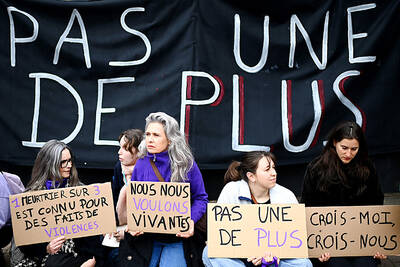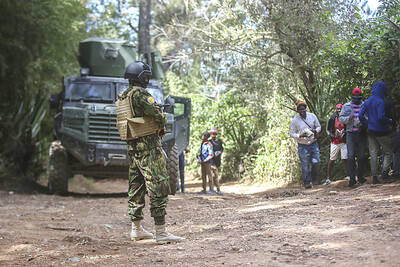Hospital doctors in England yesterday began their longest consecutive strike in the seven-decade history of the UK’s National Health Service (NHS).
Junior doctors — those below consultant level — started a six-day walkout, in a major escalation of their long-running pay dispute with the British government.
The industrial action comes at one of the busiest times of the year for the state-funded NHS, when it faces increased pressure from winter respiratory illnesses. It also quickly follows a three-day strike held by doctors just before Christmas.

Photo: AP
The NHS said the latest stoppage, which could see up to half of the medical workforce on picket lines, would have “a significant impact on almost all routine care.”
“This January could be one of the most difficult starts to the year the NHS has ever faced,” NHS Medical Director Stephen Powis said.
The strike is due to end on Tuesday next week.
The British Medical Association last month announced the walkout after a breakdown in talks with the government.
The union said that junior doctors have been offered a 3 percent rise on top of the average 8.8 percent increase they were given earlier this year.
It rejected the offer because the cash would be split unevenly across doctor grades and would “still amount to pay cuts for many doctors.”
Junior doctors have gone on strike at least seven times since March last year.
British Prime Minister Rishi Sunak and hospital leaders have criticized the action.
Health policy is a devolved matter for the administrations in Scotland, Wales and Northern Ireland, with the British government overseeing England.
Junior doctors in Wales are due to walk out for 72 hours from Jan. 15. Those in Northern Ireland have voted for a potential strike, while their Scottish counterparts have struck a deal with the government in Edinburgh.

A French-Algerian man went on trial in France on Monday for burning to death his wife in 2021, a case that shocked the public and sparked heavy criticism of police for failing to take adequate measures to protect her. Mounir Boutaa, now 48, stalked his Algerian-born wife Chahinez Daoud following their separation, and even bought a van he parked outside her house near Bordeaux in southwestern France, which he used to watch her without being detected. On May 4, 2021, he attacked her in the street, shot her in both legs, poured gasoline on her and set her on fire. A neighbor hearing

DEATH CONSTANTLY LOOMING: Decades of detention took a major toll on Iwao Hakamada’s mental health, his lawyers describing him as ‘living in a world of fantasy’ A Japanese man wrongly convicted of murder who was the world’s longest-serving death row inmate has been awarded US$1.44 million in compensation, an official said yesterday. The payout represents ¥12,500 (US$83) for each day of the more than four decades that Iwao Hakamada spent in detention, most of it on death row when each day could have been his last. It is a record for compensation of this kind, Japanese media said. The former boxer, now 89, was exonerated last year of a 1966 quadruple murder after a tireless campaign by his sister and others. The case sparked scrutiny of the justice system in

DITCH TACTICS: Kenyan officers were on their way to rescue Haitian police stuck in a ditch suspected to have been deliberately dug by Haitian gang members A Kenyan policeman deployed in Haiti has gone missing after violent gangs attacked a group of officers on a rescue mission, a UN-backed multinational security mission said in a statement yesterday. The Kenyan officers on Tuesday were on their way to rescue Haitian police stuck in a ditch “suspected to have been deliberately dug by gangs,” the statement said, adding that “specialized teams have been deployed” to search for the missing officer. Local media outlets in Haiti reported that the officer had been killed and videos of a lifeless man clothed in Kenyan uniform were shared on social media. Gang violence has left

US Vice President J.D. Vance on Friday accused Denmark of not having done enough to protect Greenland, when he visited the strategically placed and resource-rich Danish territory coveted by US President Donald Trump. Vance made his comment during a trip to the Pituffik Space Base in northwestern Greenland, a visit viewed by Copenhagen and Nuuk as a provocation. “Our message to Denmark is very simple: You have not done a good job by the people of Greenland,” Vance told a news conference. “You have under-invested in the people of Greenland, and you have under-invested in the security architecture of this